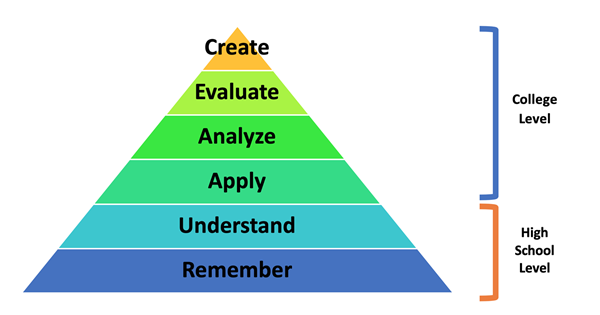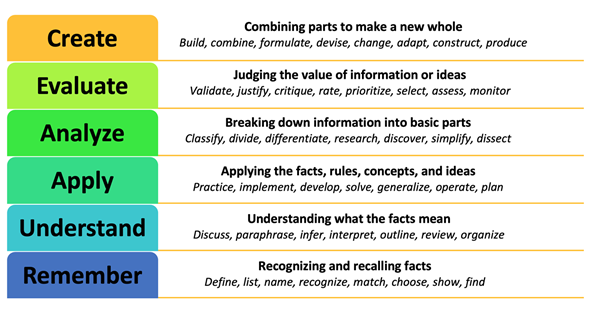Bloom's Taxonomy
Bloom’s Taxonomy describes types of learning. It is best represented as a pyramid where the foundation of learning is shown at the bottom, with increasingly more complex types of learning as you move upward.
 Image description: a pyramid showing the hierarchy of the learning process with "remember" as the foundation at the bottom and building up to the top in this order includes "understand," "apply," "analyze," "evaluate," and "create." "Remember" and "understand" are considered types of learning expected during high school and the rest of the levels (apply, analyze, evaluate, and create) are considered learning expected of college students.
Image description: a pyramid showing the hierarchy of the learning process with "remember" as the foundation at the bottom and building up to the top in this order includes "understand," "apply," "analyze," "evaluate," and "create." "Remember" and "understand" are considered types of learning expected during high school and the rest of the levels (apply, analyze, evaluate, and create) are considered learning expected of college students.In high school, you might have been responsible for acquiring basic knowledge of facts and figures, the foundational knowledge. However, college courses require more complex levels of learning, such as applying what you know to solve a problem or describe a situation, analyzing something to understand how it works, evaluating something, or creating something new.
 Image description: a graphic explaining the skills required for each of Bloom's Taxonomy levels. From bottom to top: Remember - recognizing and recalling facts. Define, list, name, recognize, match, choose, show, find. Understand - Understanding what the facts mean. Discuss, paraphrase, infer, interpret, outline, review, organize. Apply - Applying the facts, rules, concepts, and ideas. Practice, implement, develop, solve, generalize, operate, plan. Analyze - Breaking down information into basic parts. Classify, divide, differentiate, research, discover, simplify, dissect. Create - Combining parts to make a new whole. Build, combine, formulate, devise, change, adapt, construct, produce.
Image description: a graphic explaining the skills required for each of Bloom's Taxonomy levels. From bottom to top: Remember - recognizing and recalling facts. Define, list, name, recognize, match, choose, show, find. Understand - Understanding what the facts mean. Discuss, paraphrase, infer, interpret, outline, review, organize. Apply - Applying the facts, rules, concepts, and ideas. Practice, implement, develop, solve, generalize, operate, plan. Analyze - Breaking down information into basic parts. Classify, divide, differentiate, research, discover, simplify, dissect. Create - Combining parts to make a new whole. Build, combine, formulate, devise, change, adapt, construct, produce. It is important to study at the level at which you will be expected to demonstrate competency, so you might need to figure out what your professor is requesting from you. You can do this by reading the syllabus closely and looking at the assignments, by doing a post-test analysis, or by talking to your professor or teaching assistant. An academic coach from the Academic Success Center can also help you understand how to approach studying for a specific class.
 This work is licensed under a Creative Commons Attribution-NonCommercial-NoDerivs 3.0 Unported License. You may reproduce it for non-commercial use if you use the entire handout and attribute The Academic Success Center, Texas A&M University.
This work is licensed under a Creative Commons Attribution-NonCommercial-NoDerivs 3.0 Unported License. You may reproduce it for non-commercial use if you use the entire handout and attribute The Academic Success Center, Texas A&M University.